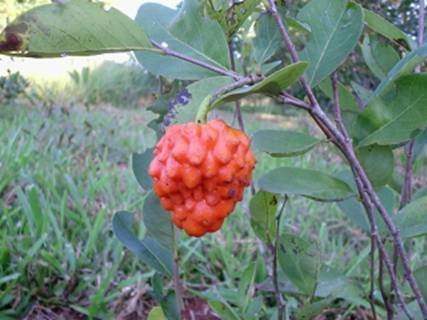ANNONA CORNIFOLIA
POPULAR NAME: RED ARACHITCHU, ARITICUM DE RAPOSA, ATA DE COBRA, ATINHA DO CAMPO.
ANNONACEAE

INDIGENOUS NAME: Caritu-cuí comes from the language of the Tupi and means "herb that gives soft fruit with color of blood" derived from words Kaá - herb and fruit, Ritu of Tikú -, soft mass of Cui and Uui - blood or reddish violet color.
Origin: The Caritu-cuí occurs in savannas and fields in the states of Goiás, Mato Grosso, São Paulo and Minhas Gerais. Brazil
Characteristics: It is a
shrub that grows in elliptical tufts of up to
Planted in the site of Frutas Raras: The Caritu-cuí was planted in December 2001 and bear fruit in February 2005 for the first time.
Tips for cultivation: Slow growing shrub which appreciates red sandy soils with rapid drainage of rain water, is resistant to light frosts to -3°C (27°F). The plant will only fruit in full sun and should be planted in virgin acid soil with pH 5.5.
Propagation:
Seeds are dormant and
take 100 days to 18 months to germinate, preferring full sun and sandy
substrate.
The seedlings grow
slowly and can be planted in place with definitely size of
Planting:
Should be planted in
full sunny virgin land in spacing of 1 to
Cultivating: The
plant grows slowly and does not require special care, it should only cover
the surface with mulch to close and eliminate any weed that can choke the
plant.
Fertilize with
Uses: The fruit pulp is sweet, aromatic and tasty, the pulp must be removed sucking and scraping the seeds with teeth.
Flowering time in the site of Frutas Raras: October to December.
Fruiting time in the site of Frutas Raras: End of January to the first half of March.